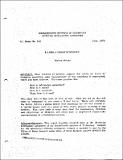Browsing Computer Science and Artificial Intelligence Lab (CSAIL) by Title
Now showing items 1747-1766 of 3804
-
K+1 Heads are Better Than K
(1976-09)There are languages which can be recognized by a deterministic (k+1)-headed one-way finite automaton but which cannot be recognized by a k-headed one-way (deterministic or non-deterministic) finite automaton. Furthermore, ... -
K-Lines: A Theory of Memory
(1979-06-01)Most theories of memory suggest that when we learn or memorize something, some "representation" of that something is constructed, stored and later retrieved. This raises questions like: How is information represented? ... -
KAM: Automatic Planning and Interpretation of Numerical Experiments Using Geometrical Methods
(1989-08-01)KAM is a computer program that can automatically plan, monitor, and interpret numerical experiments with Hamiltonian systems with two degrees of freedom. The program has recently helped solve an open problem in ... -
KBEmacs: A Step Toward the Programmer's Apprentice
(1985-05-01)The Knowledge-Based Editor in Emacs (KBEmacs) is the current demonstration system implemented as part of the Programmer's Apprentice project. KBEmacs is capable of acting as a semi-expert assistant to a person who is ... -
Keeping Mobile Robots Connected
(2009-06-17)Designing robust algorithms for mobile agents with reliable communication is difficult due to the distributed nature of computation, in mobile ad hoc networks (MANETs) the matter is exacerbated by the need to ensure ... -
Keeping Secrets in Hardware: the Microsoft Xbox(TM) Case Study
(2002-05-26)This paper discusses the hardware foundations of the cryptosystem employed by the Xbox(TM) video game console from Microsoft. A secret boot block overlay is buried within a system ASIC. This secret boot block decrypts and ... -
Kernels for Vector-Valued Functions: a Review
(2011-06-30)Kernel methods are among the most popular techniques in machine learning. From a frequentist/discriminative perspective they play a central role in regularization theory as they provide a natural choice for the hypotheses ... -
Keys Under Doormats: Mandating insecurity by requiring government access to all data and communications
(2015-07-06)Twenty years ago, law enforcement organizations lobbied to require data and communication services to engineer their products to guarantee law enforcement access to all data. After lengthy debate and vigorous predictions ... -
Kinematic Features of Unrestrained Arm Movements
(1984-07-01)Unrestrained human arm trajectories between point targets have been investigated using a three dimensional tracking apparatus, the Selspot system. Movements were executed between different points in a vertical plane ... -
Kinematics of the MIT-AI-VICARM Manipulator
(MIT Artificial Intelligence Laboratory, 1974-05)This paper describes the basic geometry of the electric manipulator designed for the Artificial Intelligence Laboratory by Victor Scheinman while on leave from Stanford University. The procedure for finding a set of joint ... -
Kinematics, Statics, and Dynamics of Two-D Manipulators
(MIT Artificial Intelligence Laboratory, 1975-06)In order to get some feeling for the kinematics, statics, and dynamics of manipulators, it is useful to separate the problem of visualizing linkages in three-space from the basic mechanics. The general-purpose two-dimensional ... -
The Kineticist's Workbench: Combining Symbolic and Numerical Methods in the Simulation of Chemical Reaction Mechanisms
(1991-05-01)The Kineticist's Workbench is a program that simulates chemical reaction mechanisms by predicting, generating, and interpreting numerical data. Prior to simulation, it analyzes a given mechanism to predict that ... -
Kintinuous: Spatially Extended KinectFusion
(2012-07-19)In this paper we present an extension to the KinectFusion algorithm that permits dense mesh-based mapping of extended scale environments in real-time. This is achieved through (i) altering the original algorithm such that ... -
Knowledge About Interfacing Descriptions
(MIT Artificial Intelligence Laboratory, 1974-03)This concentrates on interactions between knowledge stated in diverse representations. It proposes a vision program that classifies any complicated object as an elaborated instance of a simple on it already understands. ... -
Knowledge and Common Knowledge in a Byzantine Environment: Crash failures
(1986-07)By analyzing the states of knowledge that the processors attain in an unreliable system of a simple type, we capture some of the basic underlying structure of such systems. In particular, we study what facts become common ... -
Knowledge Base Integration: What Can We Learn from Database Integration Research?
(1988-01-01)This paper examines the issues and the solutions that have been studied in database (DB) integration research and tries to draw lessons from them for knowledge base (KB) integration. -
Knowledge Benchmarks in Adversarial Mechanism Design (Part I) and Implementation in Surviving Strategies (Part I)
(2008-07)We put forward new benchmarks and solution concepts for Adversarial Mechanism Design, as defined by [MV07.a], and we exemplify them in the case of truly combinatorial auctions.We benchmark the combined performance (the sum ... -
Knowledge Benchmarks in Adversarial Mechanism Design and Implementation in Surviving Strategies (Part I)
(2008-06)We put forward new benchmarks and solution concepts for Adversarial Mechanism Design, as defined by [MV07.a], and we exemplify them in the case of truly combinatorial auctions.We benchmark the combined performance (the sum ... -
Knowledge Driven Recognition of the Human Body
(MIT Artificial Intelligence Laboratory, 1976-01)This paper shows how a good internal model of the subject viewed aids in the visual recognition and following of key parts. The role of knowledge driven top-down tools and methods is shown by recognizing a series of human ... -
Knowledge Flow Analysis for Security Protocols
(2005-10-19)Knowledge flow analysis offers a simple and flexible way to find flaws in security protocols. A protocol is described by a collection of rules constraining the propagation of knowledge amongst principals. Because this ...




















